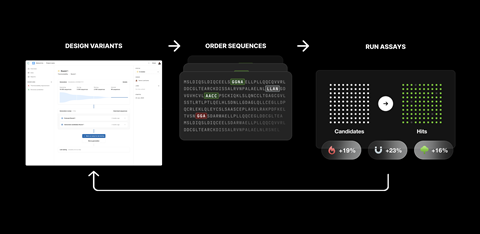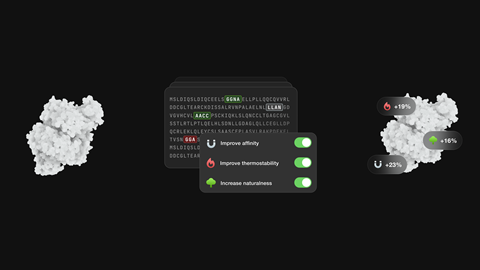It is a challenge to design and optimise proteins specifically for a given task. By applying artificial intelligence, Delft start-up Cradle aims to speed up this process.
Using artificial intelligence (AI) to design and optimise proteins. This is the ambition of the start-up company Cradle. It is clear that they are responding to a real need. It is only two years since Cradle was founded, and in that short time the team has already managed to raise €33 million from investors. Its clients now include companies such as Novozymes, Twist Bioscience and Johnson & Johnson.

Behind Cradle is a team of five ambitious entrepreneurs. One of them is Jelle Prins. He is no stranger to pioneering. ‘I started my career at Uber in 2009 to build the first mobile application for them.’ Prins went on to develop mobile applications for various parties and, in the midst of the corona crisis, was asked by the Ministry of Health to develop the corona detector.
However, Prins had long been toying with the idea of using AI in an area where it could have a big impact. He discussed the plan with an old friend, Stef van Grieken, who was then working at Google X, including on the development of special chips for artificial intelligence. They quickly came to the conclusion that an application in biotechnology could lead to interesting developments. But neither of us had a background in it. A friend suggested they contact Elise de Reus. She was currently working in the biotechnology sector in the US and wanted to return to the Netherlands. De Reus then suggested that we contact Harmen van Rossum. Eventually, Eli Bixbi joined the team. Van Grieken knew him from his time at Google X, where Bixbi worked on combining AI and biotechnology.
‘Many opportunities to harness proteins remain untapped’
Jelle Prins
Time-consuming
And so the five of them began fine-tuning the business idea in the evenings. Prins: ‘It is very difficult to design and optimise proteins specifically for a particular process. As a result, many opportunities to use proteins go unused. Suppose you have a protein that looks promising for a certain chemical conversion. By making very small changes to the amino acids, you can try to optimise that process to give you higher activity, substrate specificity, solubility or thermostability. Finding the right mutations requires a lot of laboratory work and is a time-consuming and costly affair. This means that only large companies really have the capacity to do this.’
Text file
Prins and his colleagues are using AI to speed up and improve this optimisation process. ‘Customers knock on our door with a protein that “kind of works” for a particular application. Through a web application, they can upload the protein – which is essentially a text file of 400 to about 2,000 characters representing the amino acids.’ By specifying which property the software should optimise for, our system makes suggestions and predictions. ‘We think we can optimise a protein twice as fast as with traditional methods.’ More importantly, says Prins, the chances of success are higher. ‘Regularly, protein optimisation projects are written off because there are no results from laboratory experiments. With AI, they can often achieve successful results.’

Experimental data
Cradle itself has labs to optimise proteins experimentally. ‘We train our models with data from our experiments. In the experiments, we can check whether an algorithm actually leads to an improvement in the performance of a protein. The algorithm also learns from “failures”, i.e. proteins that do not perform as well as expected.’ For example, Cradle is investigating how to improve the thermal stability of the polymerase needed to make mRNA. This knowledge is important for the production of mRNA vaccines. The company expects to present results in the first quarter of 2024.
Prins hopes that the use of AI will mean that protein design will no longer be the preserve of large companies. ‘This could make many more optimised proteins available for all kinds of processes. This could lead to breakthroughs in many different sectors. It would be great if our software became a platform that could be used by a biology student, for example, to design a protein. And then offer it on a marketplace.’













Nog geen opmerkingen